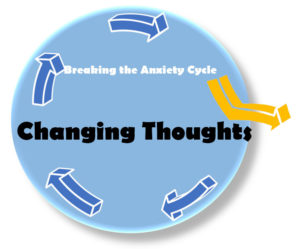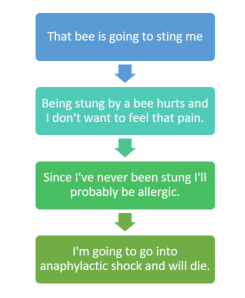
To change your thoughts, you need to identify automatic thoughts and core beliefs. An automatic thought is what you say or think automatically like “that bee is going to sting me”. That thought alone doesn’t inevitably lead to anxious feelings and avoidance behaviors.
You need to break your thought down and figure out what else am I thinking that leads me to feel anxious. This is often called the downward arrow technique. You can see below how by asking, “what about that thought makes me anxious” can help you delve deeper.
You can even go a step farther and figure out what about dying is scary to you. It’s different for each person and could be related to not feeling like you accomplished enough, worrying about what happens after death, feeling like you’ll have let people down, or feeling like no one will even notice that you’re gone. You know you’ve reached a core thought when you can say “almost every person who truly believed this thought would feel physically anxious and avoid/run from this danger”.
Thought Challenging Time
When you’ve developed a broader understanding of your thoughts you get to have some fun with them:
- Identify thoughts that are unhelpful or distorted (see this list).
- Research the validity of your thoughts.
- Identify rational thinking based on evidence.
Challenging thoughts can be difficult. This is especially true when our core beliefs have been around for a while. When we challenge thoughts, it’s not about “thinking happy thoughts”. It’s about thinking realistically based on evidence.
Let’s take the example of dying from a bee sting.
Unhelpful thinking/Cognitive Distortions
- Jumping to Conclusions/Fortune Telling: believing you know the outcome of a situation.
- Catastrophizing: assuming the worst possible outcome is bound to happen.
- Emotional Reasoning: because I feel like it’s going to happen, it must be true.
Research the validity of your thoughts
- It’s rare to die from a bee sting. About 100 people die in the US in a year by bee stings. 37,000 people die in car accidents
- The average person can tolerate 1 bee sting per 10 lbs of their body weight
Happy/Fake Thinking
- I’ll never get stung by a bee. Bees are my friends and if I just send off positive vibes the bee will go away.
Realistic/Evidence-based Thinking
- It’s rare to die from a bee sting. About 100 people die in the US by bee stings. This number is compared to 37,000 car accident deaths.
- It’s possible that I will be stung by this bee, but that’s a momentary pain. If I am allergic, I have a cell phone with me and I can seek medical attention.
It seems simple, but it works. When you change your unhelpful thoughts into realistic ones, it ends up lowering the intensity of your feeling. For more information on challenging thinking, review the “Thinking about Thinking” series (overview, mind reading, catastrophizing, emotional reasoning).

